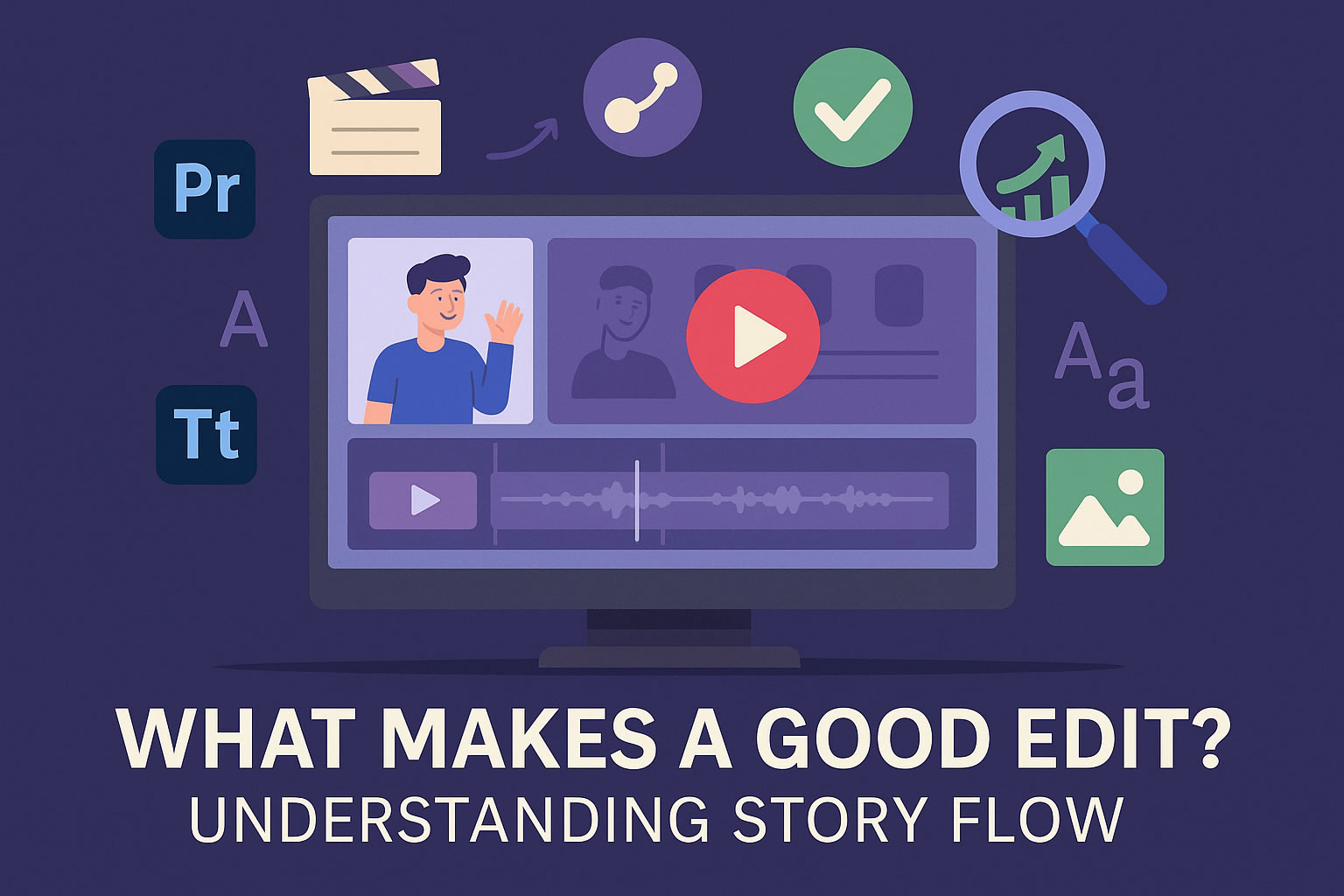What Makes a Good Edit? Mastering Story Flow in Video Editing
Introduction: More Than Just Cutting Clips
Ever watched a video that felt effortlessly smooth, where every transition, pause, or cut just made sense? That wasn’t luck—it was great video editing, and more specifically, great story flow.
Whether you’re editing a vlog, a wedding highlight, a brand promo, or a short film, understanding how to guide your viewer through a coherent, emotional, and engaging experience is what separates good editors from great ones.
In today’s visual-first world, video editing is about more than assembling clips—it’s about crafting narratives, evoking emotion, and holding attention. Let’s break down what makes a good edit by exploring the power of story flow.
What Is Story Flow in Video Editing?
Story flow refers to how smoothly and logically a video progresses from one scene or idea to the next. It’s the invisible thread that holds your video together—ensuring that each shot leads into the next with purpose and meaning.
Elements of Strong Story Flow:
- Clear beginning, middle, and end
- Logical sequencing of events or ideas
- Consistent tone and pacing
- Effective use of transitions, music, and timing
- Emotional continuity
Good story flow means your audience never gets confused, bored, or emotionally disconnected. Instead, they’re hooked from start to finish.
The Role of Editing in Storytelling
Video editing is the final rewrite of any story. It determines:
- What the audience sees
- When they see it
- How they feel about it
You can take the same raw footage and create entirely different narratives depending on how it’s edited. As Walter Murch, legendary editor of Apocalypse Now, once said, “Editing is not so much a putting together as it is a discovery of a path.”
Key Decisions Editors Make:
| Editing Decision | Impact on Story |
|---|---|
| Clip selection | Influences message & clarity |
| Cut timing | Affects rhythm & tension |
| Transition type | Sets tone or mood |
| Music & sound effects | Drives emotion |
| Order of scenes | Shapes narrative arc |
Real-World Example: The Jump Cut Revolution
Vloggers like Casey Neistat popularized the jump cut, a quick cut from one moment to another, removing pauses and fluff. It keeps the pace fast, energy high, and viewer engagement strong. This editing choice enhances story flow for a fast-moving digital audience.
In contrast, cinematic storytelling—like in Christopher Nolan’s Interstellar—uses slow transitions, long shots, and dramatic pacing to build tension and emotion.
Lesson: Story flow is audience-specific. A TikTok viewer expects a faster pace than a documentary watcher.
How to Achieve Great Story Flow in Video Editing
1. Start with a Clear Storyboard or Script
Even in post-production, clarity is key. Know your message, your audience, and your intended emotional arc.
“If you don’t know what your story is, your viewer won’t either.”
2. Match the Pace to the Purpose
Don’t cut too fast or too slow. Match the edit rhythm to your subject matter:
- Fast pace = energy, excitement, action
- Slow pace = drama, reflection, seriousness
3. Use Sound and Music Intentionally
Music can glue your story together. Match soundtrack tone with visuals:
- Upbeat music for lively montages
- Ambient or dramatic tones for emotional scenes
Fading music in and out can signal shifts in story tone or chapter.
4. Watch for Visual Continuity
Avoid jarring edits where the angle, lighting, or movement doesn’t match. Always ask:
- Does this cut feel natural?
- Does it follow visual logic?
5. Know When to Cut—and When to Let It Breathe
Sometimes, holding a shot is more powerful than cutting. Use silence, pause, and space to enhance emotional beats.
My personal tip: Watch your rough cut without sound. If the visual story still makes sense, your flow is working.
Common Story Flow Mistakes in Video Editing
Even skilled editors sometimes fall into these traps:
❌ Choppy Cuts
Cuts that don’t align with the subject’s movement or thought pattern disrupt viewer focus.
❌ Inconsistent Pacing
Switching too rapidly between fast and slow scenes without reason confuses your audience.
❌ Irrelevant Clips or B-Roll
If it doesn’t move the story forward, cut it. Simplicity is strength.
❌ Poor Audio Transitions
Abrupt changes in background noise or music ruin immersion. Always fade audio and match levels.
Tips from Industry Professionals
- The Rule of Three: Introduce an idea, reinforce it, and conclude it.
- J-cuts and L-cuts: These are where audio or visuals from the next/previous scene come in early or stay late—great for maintaining flow.
- Use visual metaphors: Match symbolic imagery with voiceover or dialogue.
Recommended Tools:
- Adobe Premiere Pro – great for advanced story flow editing
- DaVinci Resolve – known for color grading and visual continuity
- Final Cut Pro X – smooth for Mac users
Why Story Flow Matters More Than Ever
In the age of short attention spans, great video editing is no longer optional—it’s essential. Viewers decide in the first 10 seconds whether to stay or bounce.
A strong story flow ensures:
- Better engagement
- More shares and watch time
- Stronger emotional connection
- Higher conversion or message retention
Final Thoughts: Editing Is Storytelling
At its core, video editing is the art of storytelling with rhythm, visuals, and sound. It’s about guiding your viewer’s eyes, mind, and heart through a well-structured, emotionally resonant journey.
Mastering story flow is a superpower. Whether you’re a content creator, marketer, or filmmaker, learning how to craft edits that feel seamless will elevate your video projects—and your storytelling impact.
🎥 Ready to Take Your Edits to the Next Level?
If you’re serious about improving your video editing skills and mastering story flow, explore our editing services or sign up for our next free workshop. Got thoughts on this post? Drop a comment or share with your fellow editors!
Let’s create videos that don’t just inform—but move people.

